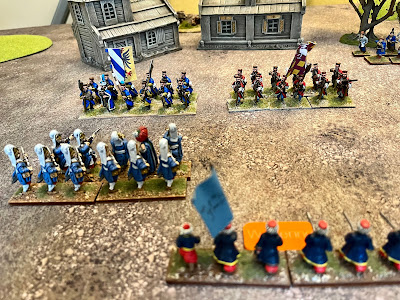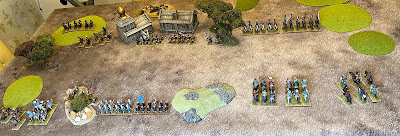This is a new book by Michal Paradowski on the Khotyn campaign 1621 fought between Poland and the Ottoman Empire. This isn't your usual set-piece battle, but it's closer to a siege in some ways.
The author starts by outlining relations between the Polish Commonwealth and the Ottomans in the early Seventeenth century. The Polish border stretched down to Moldavia, a tenuous vassal of the Ottoman Empire. Moldavians fought on both sides in this campaign. To the east were the Tartars, Ottoman allies who regularly raided into Poland, challenged by the cossack regions, which were loosely part of Poland at this time. A treaty was signed in 1617 to stop these raids both ways, but little changed in practice.
The earlier 1620 campaign gets a chapter. This went badly for the Poles, who were forced to withdraw using their wagons (tabor). The use of war wagons in wargame rules has been the subject of much debate over many years. There is an excellent contemporary description of how they were organised (page 34), which should be compulsory reading. Fortunately for the Poles, the very capable Ottoman commander, Iskander Pasha, was later killed, and his replacements were not nearly as competent.
Both military systems are covered. The Polish-Lithuanian forces included the classic indigenous units of the Polish army, including winged hussars and cossacks, as well as mercenary units in the western style, Reiters and infantry. Cossacks were mostly foot during this period; their horse were akin to dragoons, and their boats raided as far as Constantinople. Polish recruiters travelled Europe, including Britain, and a small contingent of Irish, Scots and English fought in the campaign. The Polish envoy remarked, 'Irish are best, as they are tough and good Catholics; Scots are also tough but they are really serious heretics.' I was surprised about the high proportion of hussars, although we must be cautious about the difference between paper strength and reality. In total, about 25,000 troops were available to the Polish commander.
The Ottoman numbers are even less reliable. One Polish chronicler claimed 500,000 men accompanied Sultan Osman II on this campaign. The author plumps for around 60,000, but he carefully explores the sources so you can make up your own mind. They included all the classic types, primarily provincial sipahi, Kapikulu cavalry, Janissaries and Tartars. There was also a significant Moldavian and Wallachian contingent.
The Poles assembled their forces for the campaign and advanced into Moldavia. They crossed the Dniester River and established their camp at Khotyn. The position was defensible, with a castle on one flank. The Poles started to dig in with field fortifications when they were attacked. The Ottomans concentrated on the weaker flank held by the cossacks and built their own bridge over the river to threaten the Polish supply lines. German officers with the Poles were very impressed with the Ottoman bridge. Ottoman military engineering is worth further study.
The rest of the book is a daily campaign diary; as the Ottomans attacked, the Poles sortied out in a battle that raged for over a month. In the end, a treaty was negotiated that allowed the Polish forces to withdraw back to Poland. It may not have been a great victory, but it did halt Ottoman expansion into Poland. Losses are contested, but there were probably around 20,000 on each side.
This is an excellent description of the campaign and warfare generally on this front. It is well illustrated with colour plates of the main troop types. Diaries give a personal view of the fighting alongside the strategic factors.
I dusted down my 28mm Polish and Ottoman forces for a couple of games of Pikeman's Lament last weekend. The Poles came out best in both games, mainly due to the charging power of the winged hussars. Although I was playing the Ottomans, the hussars are a lovely wargame unit.




That sounds a complex encounter. Almost like a modern battle, fought over weeks with defended positions. Fabulous looking models by the way.
ReplyDeleteChris/Nundanket
Thanks. Not all my work. I picked up the Polish infantry at a bring and buy. One of the Hussar units are old Hinchcliffe. Still looking good (and robust) all these years later.
DeleteThis book is certainly on my “must buy” list when £££’s permit.
ReplyDeleteI do have wargames forces for the Poles and Ottomans, but for the slightly later Deluge period. Mine, being in 2mm scale, don’t look anywhere near as colourful as yours 😉
Cheers,
Geoff
It is very good on the Poles. Probably not as good on the Ottomans, but in fairness the sources are limited.
Delete